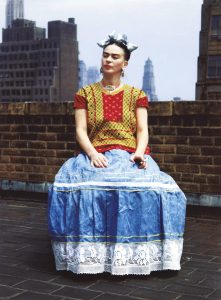
Tag Archives: imperfect body
Because Who Is Perfect?
It’s no secret that the smooth, plastic bodies staring out of store windows aren’t true physical replicas of the people who stare back at them. But there’s no reason they can’t be. Pro Infirmis, an organization for the disabled, created a series of mannequins based on real people with physical disabilities, working with individuals like Jasmine Rechsteiner, a Miss Handicap winner who has spine malformations, and Erwin Aljukić, an actor with brittle bone disease. The project’s title? “Because Who Is Perfect? Get Closer.”
LINK: http://www.huffingtonpost.com/2013/12/03/disabled-mannequins-video_n_4379586.html
CAROLINA MONACO
Frida Kahlo’s Fashion Sense
“She had the courage to paint women’s pain, which must never be revealed in patriarchal warrior societies. Yet she was true to her longing, as a female, to create beauty even out of an imperfect female body. Viva Frida! I visited Casa Azul, and everything I see and read about her still touches the deepest core of my feminine soul,”
Frida Kahlo wore her heart on her sleeve, though not the way one might think. In real life, as on the canvases of her many self-portraits, Kahlo used fashion to channel her physical and emotional insecurities into statements of strength, heritage, and beauty. Yet for nearly 50 years, her personal wardrobe remained hidden to scholars and fans alike, locked away shortly after Kahlo’s death in 1954.
“Because of its geometry, it was the perfect dress to disguise Kahlo’s imperfections and distinguish her from her famous husband.”
When Kahlo passed just after her 47th birthday, her husband and fellow artist, Diego Rivera, began placing her most personal belongings into a bathroom of their Mexico City house. Upon Rivera’s death in 1957, their home, also known as La Casa Azul or “The Blue House,” became the Museo Frida Kahlo. But shortly before Rivera died, he gave instructions to a close personal friend, Dolores Olmedo, that the room containing Frida’s wardrobe should stay locked for the next 15 years. Olmedo took Rivera’s request so seriously that she ultimately decided to keep the room sealed until her own death in 2002.
During the last decade, the museum has finally been able to catalog and organize the bathroom’s contents, which included hundreds of documents, photographs, and artworks, in addition to around 300 articles of clothing and personal objects, from a pair of earrings Picasso gave Kahlo to her customized prosthetic devices. Just last November, in collaboration with Vogue México, the museum opened the first exhibition of Kahlo’s personal garments, presenting her attire through the lens of disability and female empowerment, as well as her continued influence on fashion. The exhibition focuses on the ways Kahlo used her iconic style, often composed of traditional Tehuana garments, to project her feminist and socialist beliefs while also masking her debilitating injuries.
the history:
http://www.collectorsweekly.com/articles/uncovering-clues-in-frida-kahlos-private-wardrobe/
Enrica Sacco









